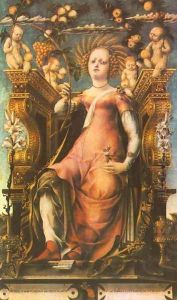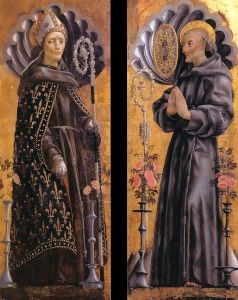Michele Pannonio Paintings
Michele Pannonio, also known as Michele Ongaro, was an early Renaissance painter, whose life and works are not extensively documented, leaving a great deal of his biography to historical conjecture based on the few available sources and surviving artworks attributed to him. His presumed birth year is around 1400, and he is believed to have been of Hungarian origin, which is suggested by the name 'Pannonio' referring to the Roman province of Pannonia, corresponding to present-day western Hungary.
Pannonio is thought to have been active primarily in Italy, with a significant portion of his career spent in Ferrara under the patronage of the Este family, who were prominent Renaissance rulers and art patrons. He is often associated with the artistic circle around Leonello d'Este, the Marquis of Ferrara, who was known for his support of artists, poets, and scholars. Pannonio's style shows the influence of the Ferrarese school, which was characterized by a blend of Northern European and Italian Renaissance elements, as well as an interest in humanism and the classical tradition.
Although the exact details of his death are not well recorded, Michele Pannonio is believed to have died around 1468. Throughout his career, Pannonio contributed to the diffusion of Renaissance ideas and aesthetics beyond Italy, particularly in Central Europe. His work is characterized by meticulous attention to detail, vibrant colors, and an interest in depicting both religious and secular subjects with a sense of grace and harmony.
Pannonio's surviving body of work is limited, and much of his art has been lost or remains unidentified. Nonetheless, the pieces attributed to him continue to be studied for their contribution to the understanding of the spread of Renaissance art and culture. His most notable works include frescoes and altarpieces that exhibit the merging of regional artistic traditions with the emerging Renaissance style. Despite the scarcity of information, Michele Pannonio is recognized as a figure who represents the interconnectedness of European art during the 15th century, linking the Italian Peninsula with the broader artistic developments of the time.

